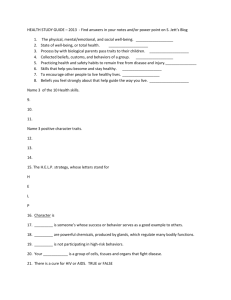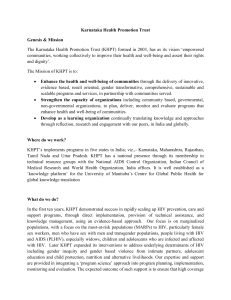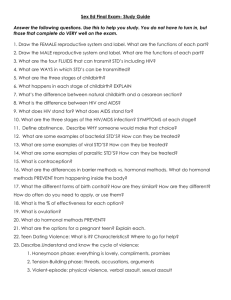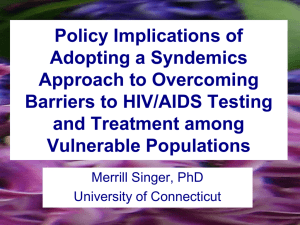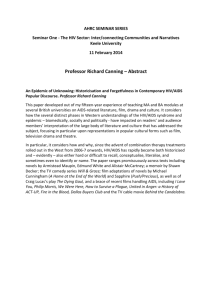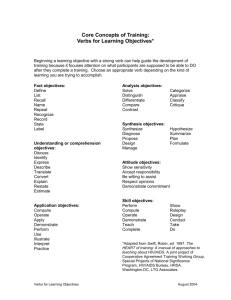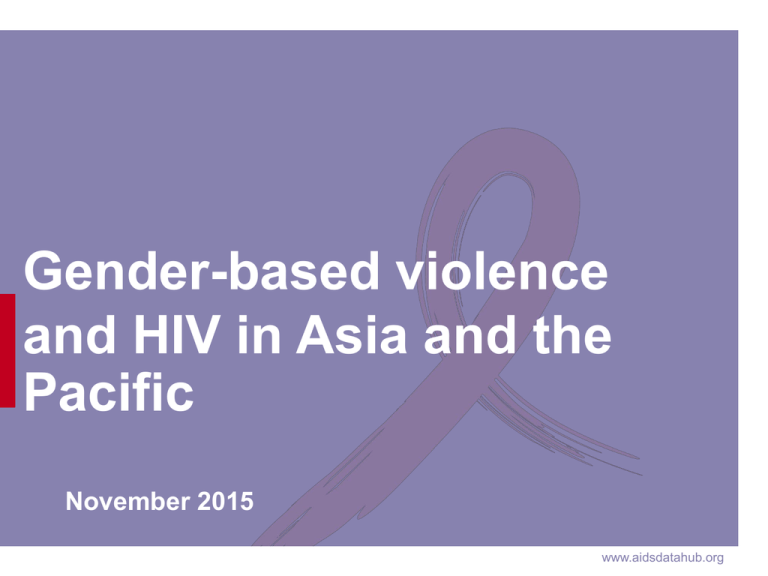
Gender-based violence
and HIV in Asia and the
Pacific
November 2015
www.aidsdatahub.org
HIV and AIDS
Data Hub for Asia-Pacific
Gender-based violence (GBV) and intimate partner
violence (IPV) can increase the risk of HIV transmission
Globally, studies have shown
that IPV can increase the risk
of HIV infection by around
50%. (3)
In Thailand, FSW who
experienced physical and/or
sexual violence are 31%
more likely to report an STI
symptom. (2)
In Asia, between 15-65% women experience violence
by their intimate partner during their lifetime. (4)
Globally, women exposed to IPV from husbands
exposed to HIV through regular unprotected multiple
partner sex have a 7-times higher HIV risk compared
with women not exposed to intimate partner violence
and whose husband did not have sex with multiple
partners. (1)
Sources: (1)Decker, M. R., Seage, G. R., Hemenway, D., Raj, A., Saggurti, N., Balaiah, D., & Silverman, J. G. (2009). Intimate Partner Violence Functions as both a Risk Marker and Risk Factor
for Women’s HIV Infection: Findings from Indian Husband-Wife Dyads. Journal of Acquired Immune Deficiency Syndromes (1999), 51(5), 593–600. http://doi.org/10.1097/QAI.0b013e3181a255d6;
(2) Decker, M. R., McCauley, H. L., Phuengsamran, D., Janyam, S., Seage, G. R., & Silverman, J. G. (2010). Violence Victimization, Sexual Risk and STI Symptoms Among a National Sample of
FSWs in Thailand. Sexually Transmitted Infections, 86(3), 236–240. http://doi.org/10.1136/sti.2009.037846; (3) Watts, C., cited in Hale, F., Vasquez, M./Development Connections, International
Community of Women Living with HIV/AIDS, UN Women. (2011). Violence Against Women Living with HIV/AIDS: A Background Paper. USA; (4) UNAIDS. (2009). HIV Transmission in Intimate
Partner Relationship in Asia. Geneva.
Violence against key
populations
www.aidsdatahub.org
HIV and AIDS
Data Hub for Asia-Pacific
Key populations who were forced to have sex, 2008-2014
%
50
Last 6 months
Last 12 months
Ever
41
40
29
30
28
25
22
20
21
16
15
13
10
2
0
Herat,
Afghanistan
(2012)
Lao PDR
(2008)
FSW
FSW
16 Terai
Port
Dhaka,
Port
Dhaka,
Kabul,
Yangon,
Highway
Moresby, Bangladesh Moresby, Bangladesh Afghanistan Myanmar
Districts, PNG (2010) (2013-14) PNG (2010) (2013-14)
(2008)
(2013-2014)
Nepal (2012)
MSW
MSW
TG
TG
Fiji
(2010-11)
MSM
MSM
Source: Prepared by www.aidsdatahub.org based on IBBS 2008 (Lao PDR); IBBS 2012 (Afghanistan); IBBS 2012 (Nepal); Kelly, A., Kupul, M., Man, W. Y. N., Nosi, S., et al. (2011). Askim Na
Save (Ask and Understand): People Who Sell and Exchange Sex in Port Moresby; Bavinton, B., Singh, N., Naiker, D. S., et al. (2011). Secret Lives, Other Voices: A Community-Based Study
Exploring Male-to-Male Sex, Gender Identity and HIV Transmission Risk in Fiji.; Khan S., et al., Rapid assessment of male vulnerabilities to HIV and sexual exploitation in Afghanistan, March 2009;
UNESCO, & Ministry of Health, Myanmar. (2015). Multi-level Risk and Protective Factors and HIV-related Risk Behaviours among Young Men who Have Sex with Men (YMSM) in Myanmar; icddr,b.
(2015). A Survey of HIV, syphilis and risk behaviors among males having sex with males, male sex workers and hijra. Global Fund Rolling Continuation Channel Project of icddr,b.
HIV and AIDS
Data Hub for Asia-Pacific
Violence against key populations
Thailand: TG and MSWs identified as
female or gay and those who took on the
anal receptive sex role in their
relationships were significantly and
independently associated (CI=95%) with
experiencing coerced sex (1)
Thailand (Pattaya):In a 2008 study, 89%
and 69% of TG and MSM, respectively,
reporting having experienced violence
as a result of their sexual/gender
identify and/or behavior. (2)
16% of female sex workers in Hunan,
China, reported work-related violence (3)
Bangladesh: 36% of MSM, 28% of TG
people (Hijras), and 45% of MSWs
reported having been raped or beaten
in the previous year. (4)
Sources: (1) Cited in Betron, M. and E. Gonzalez-Figueroa.(2009). Gender Identity, Violence, and HIV among MSM and TG: A Literature Review and a Call for Screening. Washington, DC:
Futures Group International, USAID Health Policy Initiative, Task Order 1; (2) Cited in Betron, M. (2009). Screening for Violence against MSM and Transgenders: Report on a Pilot Project in
Mexico and Thailand. Washington, DC: Futures Group, USAID Health Policy Initiative, Task Order 1; (3) Kelvin, E. A., Sun, X., Mantell, J. E., Zhou, J., Mao, J., & Peng, Y. (2013). Vulnerability to
sexual violence and participation in sex work among high-end entertainment centre workers in Hunan Province, China. Sexual Health, 10(5), 391–399. http://doi.org/10.1071/SH13044; (4) FHI 360.
(2013). Exploring Gender Based Violence Among Men Who Have Sex With Men (MSM), Male Sex Worker (MSW) and Transgender (TG) Communities in Bangladesh and Papua New Guinea.
Washington, D.C.
HIV and AIDS
Data Hub for Asia-Pacific
Proportion of female sex workers who were physically
assaulted, 2006-2012
%
last 3 months
last 12 months
60
53
51
50
45
40
32
30
17
20
21
11
10
0
Luangnamtha
16 Terai
Highway
Districts
Kathmandu
Lao PDR
(2008)*
Nepal (2012)
Nepal (2011)*
Chittagong
Fiji (2012)
Dhaka
Khulna
Bangladesh (2006-2007)*
* Street-based FSW
Source: Prepared by www.aidsdatahub.org based on Behavioural Surveys and Integrated Biological and Behavioural Surveys
HIV and AIDS
Data Hub for Asia-Pacific
Proportion of female sex workers who were physically
assaulted or harassed by police or security personnel,
2010-2012
%
30
25
25
18
20
harassed in the last 12
months
13
15
10
5
4
physically assaulted in
the last 6 months
0
6 Terai
Highway
Districts
22 Terai
Highway
Districts
Nepal (2012)
16 Terai
Highway
Districts
Papua New
Guinea (2010)
Source: Prepared by www.aidsdatahub.org based on Ministry of Health and Population, National Centre for AIDS and STD Control (NCASC). (2012). Integrated Biological and Behavioral
Surveillance Survey among Female Sex Workers in 22 Terai Highway Districts of Nepal 2012 and Kelly, A., Kupul, M., Man, W. Y. N., Nosi, S., et al. (2011). Askim Na Save (Ask and Understand):
People Who Sell and Exchange Sex in Port Moresby
HIV and AIDS
Data Hub for Asia-Pacific
Proportion of female sex workers who have been forced
to have sex, 2008-2012
6 months
%
12 months
Ever
80
64
60
40
20
18
21
24
26
21
22
21
29
7
13
Pakistan (2011)
Nepal (2011)
Nepal (2012)
Source: Prepared by www.aidsdatahub.org based on Behavioural Surveys and Integrated Biological and Behavioural Surveys
TimorLeste
(2008)
Herat
Kabul
16 Terai Highway
22 Terai Highway
Kathmandu
Pokhara
Cell phone-based
Street-based
Brothel-based
Home-based
0
Afghanistan (2012)
HIV and AIDS
Data Hub for Asia-Pacific
Proportion of FSW who were forced by clients for
unprotected sex in the last 3 months, 2005-2008
Lao PDR (2008)
52
Luang Prabang, Lao PDR (2008)
67
Cambodia (2005) *
67
* Last week
0
20
Source: Prepared by www.aidsdatahub.org based on IBBS 2008 (Lao PDR) and STI Sentinel Survey 2005 (Cambodia)
40
60
%
80
HIV and AIDS
Data Hub for Asia-Pacific
Police and client violence against sex workers
Police brutality may force sex workers into hiding, effectively excluding them from basic
health and social care services. In an effort to not be identified as a sex worker and be a
target of police corruption, many sex workers don’t carry condoms.
Economic violence including
extortion by police can prompt sex
workers to take on riskier clients or
sex acts to recover lost money. It
can also reduce financial
resources which in turn limits sex
workers’ ability to afford medical
treatment, increasing the risk of
injuries going untreated and
likelihood of HIV transmission.
In a multi-country study, published
in 2015, police personnel and
clients were the most commonly
cited people who used violence
against sex workers, across study
sites in Indonesia, Myanmar,
Nepal and Sri Lanka and across
gender categories.
Sources: Open Society Institute. (2006). Fostering Enabling Legal and Policy Environments to Protect the Health and Human Rights of Sex Workers. Johannesburg, South Africa; UNFPA.
(2015). Policy Brief. Sex Work, Violence and HIV – From Evidence to Safety. Bangkok; Bhattacharjya, M., Fulu, E. and Murthy, L. with Seshu, M.S., Cabassi, J. and VallejoMestres, M. (2015).
The Right(s) Evidence – Sex Work, Violence and HIV in Asia: A Multi-Country Qualitative Study. Bangkok: UNFPA, UNDP and APNSW (CASAM).
HIV and AIDS
Data Hub for Asia-Pacific
State-level violence against sex workers
Fiji: A 2009 study revealed that police
surveillance and the threat of criminal sanction
affects the ability of sex workers to safely
negotiate prices and condom usage with
clients. (1)
China: A 2010 study demonstrated that median
syphilis prevalence in incarcerated sex workers
was twelve-times higher than sex workers who
were not incarcerated. (2)
China: Based on 31 qualitative interviews, sex
workers felt compelled to pay large bribes to
the arresting officers to avoid detention.(3)
Thailand: FSW reported giving up to 10-17% of
their earnings as bribed to police (Migrants
FSW from Lao PDR, Cambodia, Myanmar). (4)
India: A 2011 study indicated that sex workers
who have experienced a police raid are threetimes more likely to report an STI and four-times
more likely to report client violence. (5)
PNG:15% of FSW and 21% pf TGSW
surveyed reported being forced to have sex by
police in the last 6 months. (6)
Sources: (1) McMillan K., and H. Worth (2010) Risky Business: Sex work and HIV prevention in Fiji. International HIV Research Group, UNSW, Sydney; (2) Tucker, J., Ren, Xi., Sapio, F. (2010),
“Incarcerated sex workers and HIV prevention in China: Social suffering and social justice countermeasures,” Social Science & Medicine, vol. 70 no. 1: 121-129; (3) Asia Catalyst 2013:
asiacatalyst.org/blog/AsiaCatalyst_CustodyEducation2013-12-EN.pdf; (4) EMPOWER Foundation (2012). Hit and Run: The Impact of Anti Trafficking Policy and Practice on Sex Worker’s Human
Rights in Thailand. Bangkok: RATS-W Team EMPOWER Foundation; (5) Erausquin, J.T., Reed, E., Blankenship, K.M. (2011), Police-Related Experiences and HIV Risk Among Female Sex
Workers in Andhra Pradesh, India, Journal of Infectious Diseases, vol. 204 (Suppl. 5):1223–1228; (6) Kelly, A., Kupul, M., Man, W.Y.N., Nosi, S., Lote, N., Rawstorne, P., Halim, G., Ryan, C. &
Worth, H. (2011) Askim na save (Ask and understand): People who sell and/or exchange sex in Port Moresby. Key Quantitative Findings. Papua New Guinea Institute of Medical Research and
the University of New South Wales: Sydney, Australia;
HIV and AIDS
Data Hub for Asia-Pacific
Violence and impunity
Early age of perpetration of violence
23% of men who raped in Bougainville, PNG, and 16% in Cambodia
were 14 years or younger when they first committed this crime. (2)
Inclusion of boys and men in all responses to eliminate
gender-based violence and abuse is crucial.
Making sure that key populations know their rights is not sufficient, they also need to
know where to seek help without facing stigma and discrimination.
In Cambodia 67% of PLHIV who had their rights violated had attempted
to access legal assistance but only 6% knew about any legal services
or human rights organizations to approach for help. (1)
Between 72-97% of the respondents who had
perpetrated rape did so in complete impunity. (2)
Sources: (1) Cambodian People Living with HIV Network (CPN+) (2010). People Living with HIV Stigma Index. Phnom Penh. (2) Fulu, E., Warner, X., Miedema, S., Jewkes R., Roselli,
T., Lang, J. (2013). Why Do Some Men Use Violence Against Women and How Can We Prevent It? Quantitative Findings from the United Nations Multi-country Study on Men and
Violence in Asia and the Pacific. Bangkok: UNDP, UNFPA, UN Women and UNV.
HIV and AIDS
Data Hub for Asia-Pacific
Intimate partner violence (IPV)
Studies have shown that key populations in Asia and the Pacific experience intimate
partner violence
In Pakistan, up to 66% of
FSW faced physical
violence and 34% faced
sexual violence from their
intimate partners. (1)
In PNG 29% of TGSW
were physically assaulted
by a family member. (3)
In China 55% of FSW
reported emotional
violence, 20% reported
physical violence, and 16%
reported sexual violence. (2)
Violence against MSM and
TG is used as a way to
subordinate them to
inferior feminine roles. (4)
Sources: (1) Hawkes, S., et al. (2009). “HIV and other sexually transmitted infections among men, transgenders and women selling sex in two cities in Pakistan: A cross-sectional prevalence
survey,” Sexually Transmitted Infections, vol. 85;Suppl. 2:8–16; (2) Zhang, C., Li, X., Hong, Y., Chen, Y., Liu, W., Zhou, Y. Partner violence and HIV risk among female sex workers in China.
AIDS Behav. 2012 May;16(4):1020-30. doi: 10.1007/s10461-011-9967-0; (3) Kelly, A., Kupul, M., Man, W.Y.N., Nosi, S., Lote, N., Rawstorne, P., Halim, G., Ryan, C. & Worth, H. (2011) Askim na
save (Ask and understand): People who sell and/or exchange sex in Port Moresby. Key Quantitative Findings. Papua New Guinea Institute of Medical Research and the University of New South
Wales: Sydney, Australia; (4) Cited in Betron, M. and E. Gonzalez-Figueroa. Task Order 1. (2009). Gender Identity, Violence, and HIV among MSM and TG: A Literature Review and a Call for
Screening. Washington, DC: Futures Group International, USAID |Health Policy Initiative, Task Order 1.
Gender-based violence
against women and girls
living with HIV
www.aidsdatahub.org
HIV and AIDS
Data Hub for Asia-Pacific
Proportion of women living with HIV who had a desire to
have children reported being coerced to undergo
sterilization, 2012-2013
35%
30%
25%
20%
33%
15%
22%
10%
5%
11%
11%
Indonesia
(2012-2013)
Philippines
(2012-2013)
5%
0%
Lao PDR
(2013)
Source: Prepared by www.aidsdatahub.org based on http://apnmata.org/country-profiles/
Pakistan
(2012-2013)
Nepal
(2012-2013)
HIV and AIDS
Data Hub for Asia-Pacific
Proportion of surveyed HIV-positive pregnant women
who were asked to undergo sterilization, 2011
50%
40%
30%
20%
10%
35%
15%
15%
18%
Nepal
Bangladesh
Viet Nam
39%
40%
India
Indonesia
0%
Cambodia
Source: Prepared by www.aidsdatahub.org based on Women of the Asia Pacific Network of People Living with HIV (APN+). (2012). Positive and Pregnant. How Dare You. A study
on access to reproductive and maternal health care for women living with HIV in Asia. Bangkok.
HIV and AIDS
Data Hub for Asia-Pacific
Number of HIV-positive pregnant women who were asked
to undergo sterilization and had the option to decline, 2011
Number of HIV-positive
pregnant women
80
70
70
67
60
50
40
34
39
44
39
36
25
30
20
10
Asked to undergo
sterilisation
5
2
6
1
Had the option to
decline
0
Source: Prepared by www.aidsdatahub.org based on Women of the Asia Pacific Network of People Living with HIV. (2012). ‘Positive and Pregnant. How Dare You. A study on access to
reproductive and maternal health care for women living with HIV in Asia. Bangkok.
HIV and AIDS
Data Hub for Asia-Pacific
Violence as a consequence of HIV
The People Living with HIV Stigma
Index shows that women living with
HIV in Asia and the Pacific are more
likely than men living with HIV in the
to be the target of verbal abuse and
physical violence as a direct result of
their HIV status. (1)
The People Living with HIV Stigma Index
report for Fiji revealed that 13% of
respondents had experienced forced
disclosure of HIV status to sexual
partners. Forced disclosure of HIV status
and breach of patient confidentiality by
healthcare providers has the potential of
increasing women’s – as well as men’s –
risk of violence, including IPV. (4)
In a survey of 757 women living with
HIV in Asia, 30% reported having been
advised to undergo sterilisation. Many
stated they did not feel they had the
right to refuse the recommendation.
More than half (61%) indicated these
recommendations came from
gynaecologists and HIV clinicians on
the basis of the women’s HIV-positive
status. (2)
The People Living with HIV
Stigma Index report for
Pakistan found that 37% of
the 228 female respondents
felt they had been coerced by
a healthcare professional into
an abortion. (3)
Sources: (1) GNP+, ICW, IPPF, UNAIDS. (2011). People Living with HIV Stigma Index: Asia Pacific Regional Analysis 2011. Bangkok; (2) Asia Pacific Network of People Living with HIV (APN+)
(2012). Positive and Pregnant: How Dare You. A study on access to reproductive and maternal health care for women living with HIV in Asia. Bangkok; (3) The Association of People living with
HIV and AIDS (APLHIV). (2012) The People Living with HIV Stigma Index: An index to measure the stigma and discrimination experienced by people living with HIV in Pakistan 2009-10.
Islamabad; (4) The Fiji Network for People Living with HIV AIDS (2010). People Living with HIV Stigma Index – Fiji Islands. Suva.
Violence against women
in the general population
www.aidsdatahub.org
HIV and AIDS
Data Hub for Asia-Pacific
Proportion of women (15-49) who have experienced
physical violence during pregnancy, 2005-2014
Maldives (2006)
6
Nepal (2011)
6
Viet Nam (2009)
5
Thailand (2005)
4
Bangladesh (2006)
4
Philippines (2013)
4
Cambodia (2014)
4
Timor Leste (2009-2010)
4
0
2
4
6
8
%
Sources: Prepared by www.aidsdatahub.org based on Demographic and Health Surveys; Viet Nam General Statistics Office .(2010). ‘Keeping Silent Is Dying’ Results from the National Study on
Domestic Violence against Women in Viet Nam; Ministry of Gender and Family. Ministry of Gender and Family. (2007). The Maldives Study on Women’s Health and Life Experiences: Initial results on
prevalence, health outcomes and women’s responses to violence. Malé.; Garcia-Moreno, C., Jansen, H., Ellsberg, M., Heise, L. and Watts, C. (2005). WHO Multi-country Study on Women's Health
and Domestic Violence against Women. World Health Organization. Geneva.
HIV and AIDS
Data Hub for Asia-Pacific
Proportion of women (15-49) who have ever experienced
physical or sexual violence, 2005-2014
100
physical violence
%
sexual violence
80
60
49
6
6
Rural
Total
Urban
10
9
20
19
6
7
6
4
3
3
Total
6
20
12
Rural
6
13
11
28
22
Urban
22
19
38
35
32
Total
20
34
Rural
28
20
18
Urban
20
34
Urban
36
40
Cambodia
(2014)
India
(2005-06)
Nepal
(2011)
Source: Prepared by www.aidsdatahub.org based on Demographic and Health Surveys
Total
Rural
Urban
Total
Rural
Urban
Total
Rural
0
Pakistan
(2012-13)
Philippines
(2013)
Timor Leste
(2009)
HIV and AIDS
Data Hub for Asia-Pacific
Proportion of women (15-49) who have experienced
physical violence in the last 12 months, 2006-2014
% 100
80
60
40
29
19
20
6
8
8
9
Philippines
(2013)
Bangladesh
(2006)
Cambodia
(2014)
Nepal
(2011)
0
Source: Prepared by www.aidsdatahub.org based on Demographic and Health Surveys
India
(2005-2006)
Timor Leste
(2009-2010)
HIV and AIDS
Data Hub for Asia-Pacific
Proportion of women who have experienced sexual
violence by spouse or intimate partner, 2005-2014
20
%
Last 12 months
18
18
Ever
16
14
14
12
8
2
7
7
5
6
4
10
10
10
8
6
4
2
3
2
3
2
0
Bangladesh Timor Leste Philippines
(2006)
(2009-2010)
(2013)
Cambodia
(2014)
Maldives
(2006)
Viet Nam
(2009)
India
(2005-2006)
Nepal
(2011)
Pakistan
(2013)*
* Physical or sexual violence
Source: Prepared by www.aidsdatahub.org based on Demographic and Health Surveys;Viet Nam General Statistics Office . (2010). ‘Keeping Silent Is Dying’ Results from the National
Study on Domestic Violence against Women in Viet Nam. Ministry of Gender and Family; Ministry of Gender and Family. (2007). The Maldives Study on Women’s Health and Life
Experiences: Initial results on prevalence, health outcomes and women’s responses to violence. Malé.
HIV and AIDS
Data Hub for Asia-Pacific
Proportion of women who have experienced intimate partner
violence in the last 12 months, Pacific Island Countries and
Territories, 2007-2009
%
40
35
30
physical violence
25
20
15
10
sexual violence
5
0
Marshall Islands
(2007)
Tuvalu
(2007)
Kiribati
(2008)
Vanuatu
(2009)
Source: Prepared by www.aidsdatahub.org based on Demographic and Health Surveys; Vanuatu Women’s Centre. (2011). The Vanuatu National Survey on Women’s Lives and Family
Relationships. VWC. Port Vila.; Secretariat of the Pacific Community for Ministry of Internal and Social Affairs. (2010). Kiribati Family Health and Support Study: A study on violence against
women and children. Ministry of Internal and Social Affairs, South Tarawa.
HIV and AIDS
Data Hub for Asia-Pacific
Prevalence of men’s lifetime perpetration of physical
and/or sexual partner violence, by site, 2010-2013
% of men reporting
Bangladesh (rural)
42
Bangladesh (urban)
Cambodia (national)
10 5
45
12 5
8 3
17
Physical violence only
China (urban/rural)
32
Indonesia (rural)
7 4
Indonesia (urban)
6 6
Indonesia (Papua)
16
PNG (Bougainville)
Sri Lanka (national)
13
14
Both physical and sexual
violence
18
21
21
17
7
41
7
Sexual violence
22
18
9
Source: Fulu, E., Warner, X., Miedema, S., Jewkes R., Roselli, T., Lang, J. (2013). Why Do Some Men Use Violence Against Women and How Can We Prevent It? Quantitative Findings from the
United Nations Multi-country Study on Men and Violence in Asia and the Pacific. Bangkok: UNDP, UNFPA, UN Women and UNV.
HIV and AIDS
Data Hub for Asia-Pacific
Sexual violence against women
Source: Fulu, E., Warner, X., Miedema, S., Jewkes R., Roselli, T., Lang, J. (2013). Why Do Some Men Use Violence Against Women and How Can We Prevent It? Quantitative Findings from the
United Nations Multi-country Study on Men and Violence in Asia and the Pacific. Bangkok: UNDP, UNFPA, UN Women and UNV.
HIV and AIDS
Data Hub for Asia-Pacific
Proportion of men (15-49) who agree that a husband is
justified in hitting or beating his wife if she refuses to
have sexual intercourse with him, 2005-2014
%
50
40
Urban
30
30
27
20
20
16
16
10
2
4 4
5
10 8
9
4 3
2
7
4 5
Total
0
Cambodia
(2014)
India
(2005-06)
Indonesia
(2012)
Source: Prepared by www.aidsdatahub.org based on Demographic and Health Surveys
Pakistan
(2012-13)
Samoa
(2009)
Rural
Timor-Leste
(2009-10)
HIV and AIDS
Data Hub for Asia-Pacific
Acceptance of violence prevents women from reporting
violence
Reported prevalence of physical and/or sexual intimate partner violence
by site, comparison of men (perpetrated) and women (experienced) reports
Sri Lanka (national)
28
33
68
PNG (Bougainville)
80
Cambodia (national)
Bangladesh (urban)
Bangladesh (rural)
Women
39
China (urban/rural)
52
25
Men
33
53
55
62
57
Source: Fulu, E., Warner, X., Miedema, S., Jewkes R., Roselli, T., Lang, J. (2013). Why Do Some Men Use Violence Against Women and How Can We Prevent It? Quantitative Findings from the
United Nations Multi-country Study on Men and Violence in Asia and the Pacific. Bangkok: UNDP, UNFPA, UN Women and UNV.
HIV and AIDS
Data Hub for Asia-Pacific
THANK YOU
slides compiled by www.aidsdatahub.org and
UNAIDS Regional Support Team for Asia and
the Pacific
Data shown in this slide set are comprehensive to the extent they are available from country reports.
Please inform us if you know of sources where more recent data can be used.
Please acknowledge www.aidsdatahub.org if slides are lifted directly from this site.

